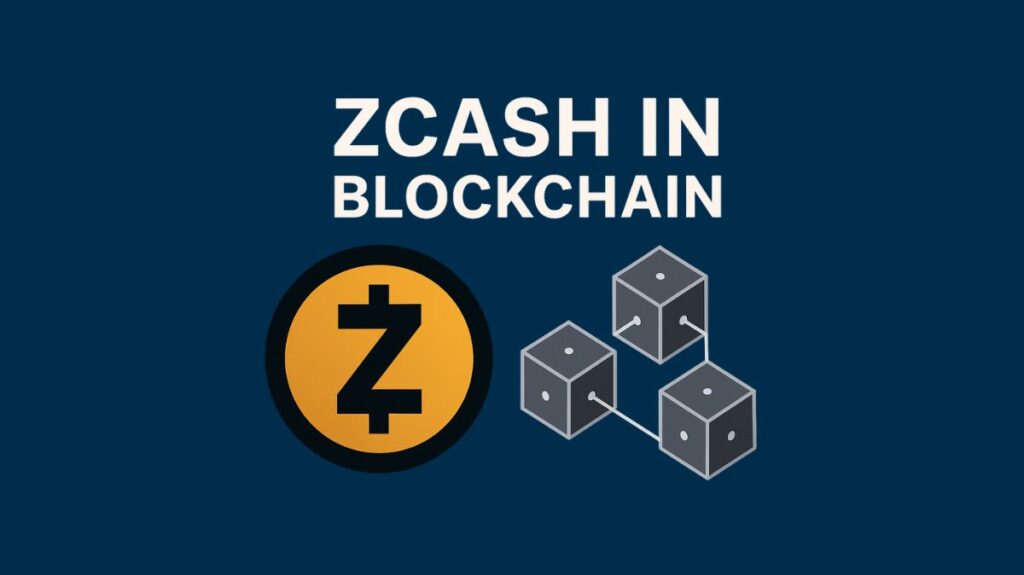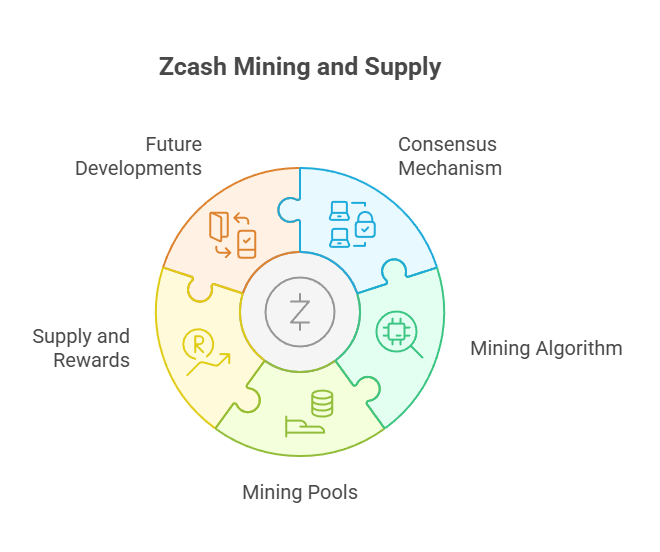In this article, we learn about Zcash Mining in Blockchain, History, how it works, and features
The purpose of the cryptocurrency Zcash is to promote economic independence. Zcash is similar to Bitcoin because it was built using the original Bitcoin code. Its privacy function protects holdings and encrypts transaction data. It is encrypted electronic cash like Bitcoin and other cryptocurrencies and provides more anonymity and privacy.

Origins and History
- Foundation: Zcash was founded in October 2016 by a team of scientists led by Zooko Wilcox-O’Hearn. It emerged from the “Zerocash protocol” and was initially based on Bitcoin’s original codebase.
- Developers: The Zerocoin Electric Coin Company (now Electric Coin Company or ECC) was formed in 2015 to engineer and deliver the idea. ECC created and launched Zcash in 2016 and continues to support the Zcash community alongside other independent teams and developers. The Zcash protocol was developed by professors and academic researchers from Johns Hopkins University, MIT, Tel Aviv University, and Technion.
- Zcash Foundation: The Zcash Foundation, a 501(c)(3) public charity, was launched in March 2017 to ensure the network’s continued development and builds financial privacy infrastructure. In 2019, ECC passed the trademark and license for Zcash to the Zcash Foundation. ECC announced its intent to terminate this agreement in April 2024, aiming to pass all governance decisions to the Foundation, effectively removing itself from the project.
You can also read Definition For Ripple: The Cryptocurrency Company Protocol
How Zcash Works: Privacy Through Zero-Knowledge Proofs
Zcash uses advanced applied cryptography, specifically a sophisticated zero-knowledge proving scheme called zk-SNARKs (Zero-Knowledge Succinct Non-Interactive Arguments of Knowledge), to preserve confidentiality and hide connections between shielded transactions.
- Functionality: Zk-SNARKs encrypt blockchain transactions without losing validity. This means that one can prove data ownership, such as a secret key, without revealing it. Observers are unable to determine whether wallets, exchanges, or other parties are participating in a transaction because of this technology.
- Transaction Types and Addresses: Zcash gives users options, letting them select between private and public transactions.
- Z-addresses (Shielded Addresses): These enable “shielded transactions” (z Txs), where the sender’s address, recipient’s address, transaction amount, and memo fields are all encrypted and not publicly visible. A Z-to-Z transaction appears on the public blockchain, showing that it occurred and fees were paid, but details remain private.
- T-addresses (Transparent Addresses): These facilitate “unshielded transactions” (t Txs), which work like Bitcoin transactions where all details are public.
- Interoperability: The two address types are interchangeable, allowing funds to be sent between them. Zcash supports four main transaction types based on shielding: z-to-z (fully private), z-to-t (sender shielded, receiver public), t-to-z (receiver shielded, sender public), and t-to-t (fully public).
- Selective Disclosure: Z-address users can selectively share transaction details through a view key, which allows read-only access. This feature is useful for purposes such as auditing, anti-money laundering (AML), and tax regulations.
- Adoption of Shielded Feature: Only about 3.5% of Zcash coins are apparently housed in shielded addresses, suggesting that most network transactions are public, despite the shielded feature’s high privacy characteristics, according to study.
You can also read Cryptocurrencies With Finite Supply: Digital Gold Standard
Unique Features and Goals
Zcash was created to encourage regulatory compliance while being effective, secure, and anonymous.
- True Anonymity: Unlike the pseudonymity of Bitcoin and most cryptocurrencies, Zcash offers true anonymity for users and their transactions because zk-SNARKs mean users don’t need to reveal their addresses to each other, greatly reducing information exposure.
- Fast and Low Fees: Zcash transactions are usually quick and cost very little, usually less than one penny. Its block duration of 75 seconds is a lot quicker than Bitcoin’s 10-minute limit.
- Secret Messages: Users have the option to include private messages with their purchases.
- Decentralized Control: Zcash is a decentralized protocol, meaning users have control over their money.
- Self-Funded Development: To enhance Zcash’s functionality and user experience, a decentralised ecosystem of developers is compensated.
- Open and Accessible: Zcash wants to be a free and open money that can be used by anybody with an internet connection, regardless of their demography or social standing.
Comparison to Bitcoin
Because Zcash and Bitcoin share a codebase and similar design ideas, they are frequently compared. However, there are some important differences:
- Codebase: The original codebase of Bitcoin was forked to create Zcash. The zcashd full node software is based on Bitcoin Core v0.11.2, although there are significant differences between the two codebases.
- One of the main differentiators is privacy. Bitcoin transactions are transparent, so anyone can find the parties. Although the blockchain is visible, zk-SNARKs anonymise transaction data in Zcash.
- Equihash is Zcash’s hashing algorithm; Bitcoin uses SHA-256. Bitcoin mining gear doesn’t support Equihash.
- Block Time: Zcash has a 75-second block time, much faster than Bitcoin’s 10-minute block time.
- Supply Cap: Both Zcash and Bitcoin have a hard cap on their total supply, set at 21 million units.
- Value Proposition: Because of its privacy features, ZEC is regarded as a superior depiction of digital currency even if it still has the decentralization and other qualities that make Bitcoin valuable.
You can also read Pseudonymity And Anonymity In Blockchain, & Its Differences
Zcash Mining and Supply

Zcash Mining and Supply
- Consensus Mechanism: Zcash uses a Proof-of-Work (PoW) consensus mechanism, similar to Bitcoin. Miners solve computationally difficult cryptographic puzzles to produce new blocks and secure the network.
- Mining Algorithm: Zcash uses the Equihash algorithm, which requires custom-designed ASIC (Application-Specific Integrated Circuit) miners for efficient mining. While it was previously possible to mine with CPUs and GPUs, ASICs are now the preferred hardware due to increased network difficulty.
- Joining a mining pool is advised for a more consistent of revenue because solo mining is frequently unprofitable due to the high network difficulty.
- Supply and Rewards:
- There are 21,000,000 ZEC tokens available in total.
- PoW is used to mine new ZEC, and periodic halvings of mining rewards take place.
- No Initial Coin Offering (ICO) was conducted by Zcash. As a “Founders Reward,” the founders received 2.1 million, or 10% of the total ZEC created. The “Founders Reward” was eliminated since the November 2020 halving event, and miners now receive 80% of block rewards (currently 3.125 ZEC), with the remaining 20% going to the Major Grants Fund (8%), ECC (7%), and the Zcash Foundation (5%).
- Future Developments: Wilcox-O’Hearn, the founder of Zcash, has argued for a possible switch from the energy-intensive Proof-of-Work (PoW) method to the more environmentally friendly Proof-of-Stake (PoS) method, which is thought to be lighter, faster, more secure, and less expensive. They do add, though, that Zcash uses Proof-of-Work and will never support Proof-of-Stake.
Zcash Ecosystem and Usage
With its Layer 1 (L1) network, Zcash is made for value movement and can be used as a payment method or as a tool for speculative investments.
- Wallets: Users need an appropriate Zcash wallet to run a node or transact. Recommended wallets are often “shielded by default”. Options include:
- Self-custody wallets: Zingo!, Edge Wallet, Unstoppable (multi-currency), Nighthawk (opensource, privacy-focused, shielded by default), Ywallet (privacy-oriented for Ycash and Zcash), and Zashi (Zcash-only, automatically protected).
- Hardware wallets: Ledger (sometimes referred to as ZEC storage, but not specifically specified in the given) and Trezor Model T. The most secure alternative for larger quantities is a hardware wallet.
- Software wallets: Available as smartphone or desktop apps, can be custodial or non-custodial.
- Online/Web wallets: Usually less secure than hardware or software wallets, but free and available via a variety of devices.
- Exchanges: Zcash can be bought or traded on most major exchanges. Examples include:
- Gemini
- Coinbase
- Binance
- Kraken
- ChangeNOW
- Airtm
- Bitfinex
- Poloniex
- Flyp.me
- StealthEx
- KuCoin
- BitcoinVN.
- Other Participants: The Zcash ecosystem consists of custodians (like Fireblocks, BitGo), block explorers (like Blockchair, Bitquery, ZEC Block Explorer), and other developers, contributors, and partners.
Criticisms
Zcash is criticised for its anonymity, which cybercriminals may use for illicit transactions on the dark web. However, Zcash backers say it can help businesses protect trade secrets and let customers buy private items safely.
You can also read Litecoin: History, How To Mine Litecoin And Litecoin Setup
